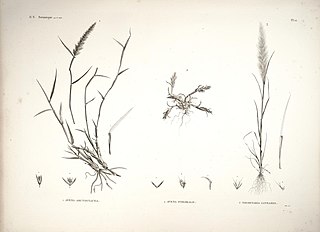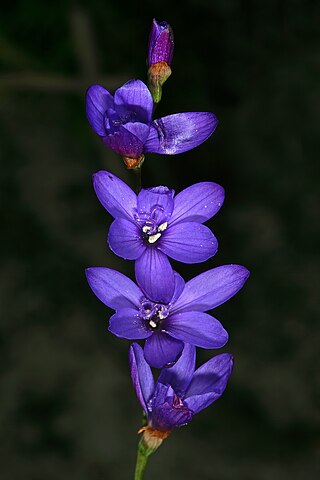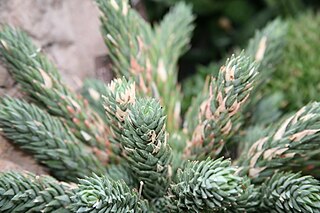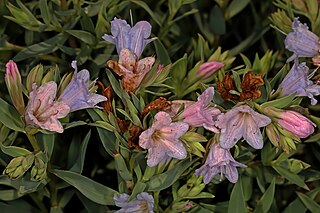
Strelitzia reginae, commonly known as the crane flower, bird of paradise, or isigude in Nguni, is a species of flowering plant native to the Cape Provinces and KwaZulu-Natal in South Africa. An evergreen perennial, it is widely cultivated for its dramatic flowers. In temperate areas it is a popular houseplant.

Delosperma cooperi, the trailing Iceplant, hardy iceplant or pink carpet, is a dwarf perennial plant native to South Africa. It forms a dense lawn with abundant, long-lasting flowers. It reaches sizes of approximately 10–15 cm (4–6 in) tall, with fleshy leaves that are linear and simple and can grow up to 1.5 inches long and a trailing stem that hangs down. These fleshy roots help provide the ability for the plants to recover and grow rapidly if a disturbance has occurred.

Protea laurifolia, also known as the grey-leaf sugarbush, is a shrub from South Africa. It is native to the Cape Provinces of South Africa.

Bewsia is a genus of African plants in the grass family. The only known species is Bewsia biflora, widespread across much of sub-Saharan Africa from Ivory Coast to Tanzania to KwaZulu-Natal.

Centropodia is a genus of Asian and African plants in the grass family.

Geissorhiza aspera, also known as the blue satin flower or blou sysie, is a geophyte from South Africa.

Haworthiopsis glauca, formerly Haworthia glauca, is a species of flowering succulent plant from the Eastern Cape Province, South Africa.

Eragrostis echinochloidea, is a species of grass native to South Africa. Listed as "safe" (LC) on the SANBI Red List, the plant can also be found in Zimbabwe, Botswana, and Namibia.

Stipagrostis namaquensis is a species of grass native to Botswana, Namibia, Lesotho, and the Cape Provinces and Free State of South Africa, especially in the Nama Karoo. It is listed as "safe" (LC) on the SANBI Red List.
Lobostemon daltonii, the Infanta healthbush, is a species of the forget-me-not family endemic to the Cape Provinces of South Africa.
Lobostemon echioides, the common healthbush, is the mostly widely distributed species in its genus. It is endemic to the Cape Provinces of South Africa, where it is found growing between Namaqualand and the Karoo and the Eastern Cape.

Lobostemon glaucophyllus, the smooth-leaved bush bugloss or grey healthbush, is a South African plant species belonging to the forget-me-not family. It is endemic to South Africa's Cape Provinces.

Zyrphelis decumbens is a species of perennial plant from the Bainskloof Mountains in the Cape Provinces of South Africa.
Ursinia punctata is a species of plant belonging to the daisy family. It is found growing in South Africa, where it has a wide distribution.
Athanasia pectinata is a species of plant from the Western Cape of South Africa.
Ursinia nudicaulis, also known as the longstalk paraseed or the little daisy is a species of plant from South Africa. It belongs to the daisy family.
Isoetes stellenbossiensis, the Stellenbosch quillwort or Cape Flats quillwort, is a species of plant from South Africa.

Nemesia linearis, also known as the witleeubekkie in Afrikaans, is a species of plant from southern Africa. It is found in South Africa and Namibia.

Heliophila pusilla, the dainty sunspurge, is a species of plant in family Brassicaceae. It is endemic to the Cape Provinces of South Africa.
Lachenalia variegata, also known as the spotty viooltjie, is a species of plant from the Western Cape of South Africa.













